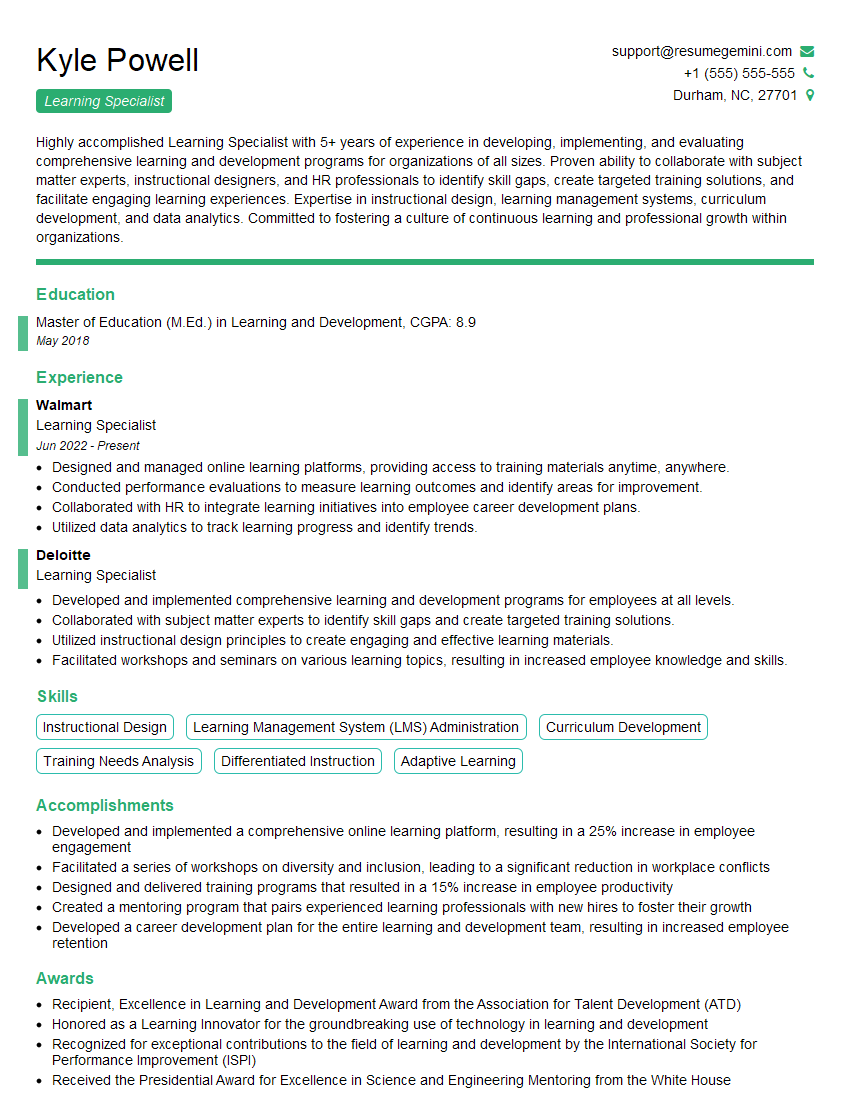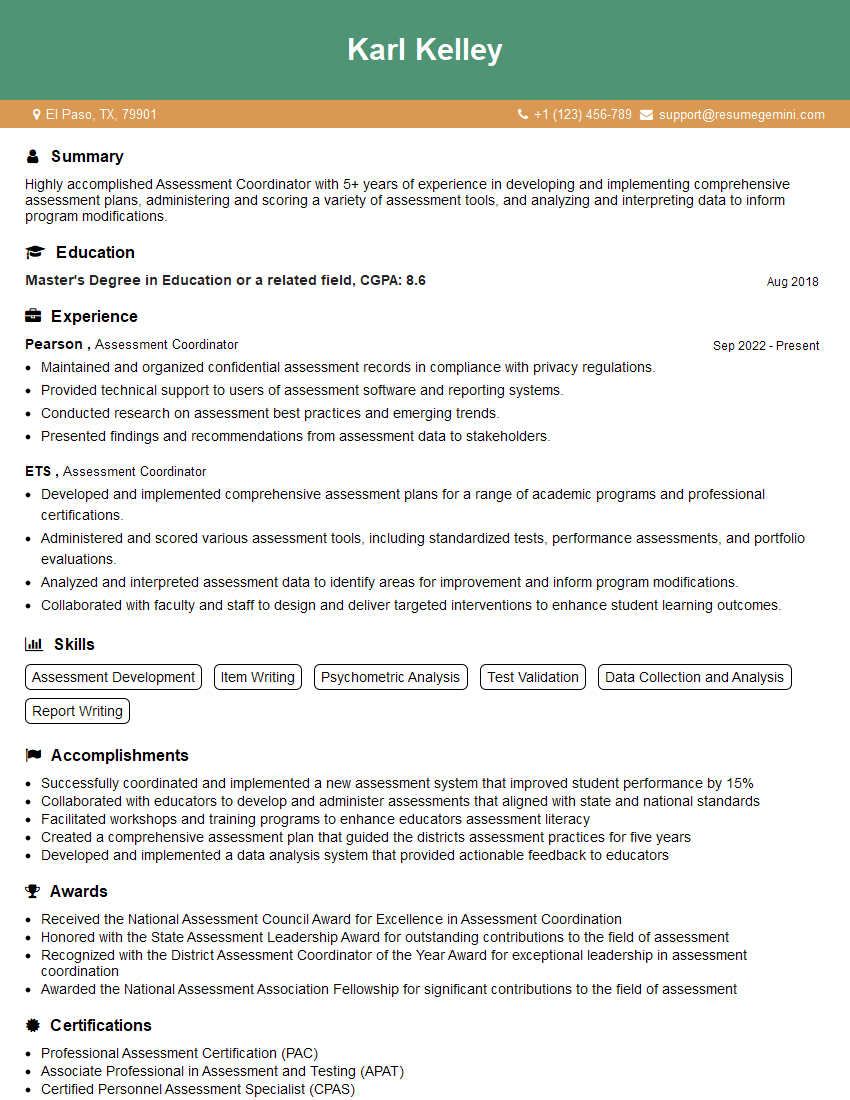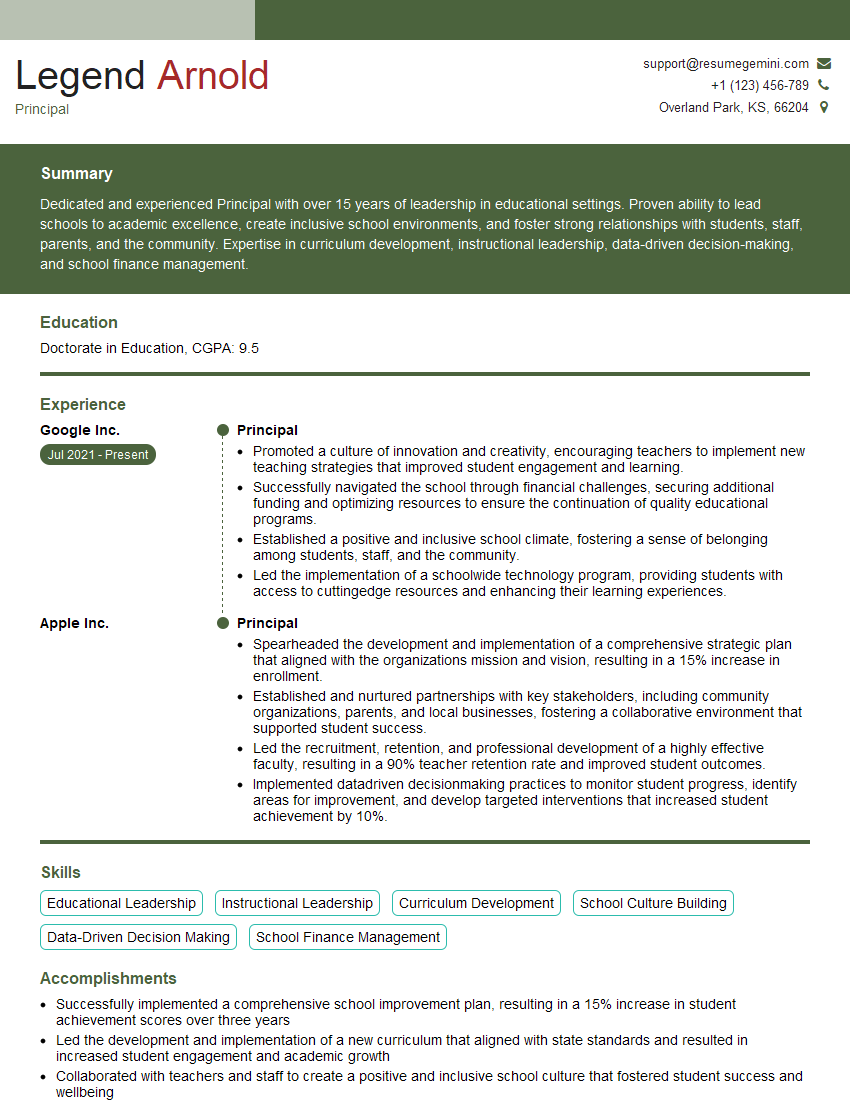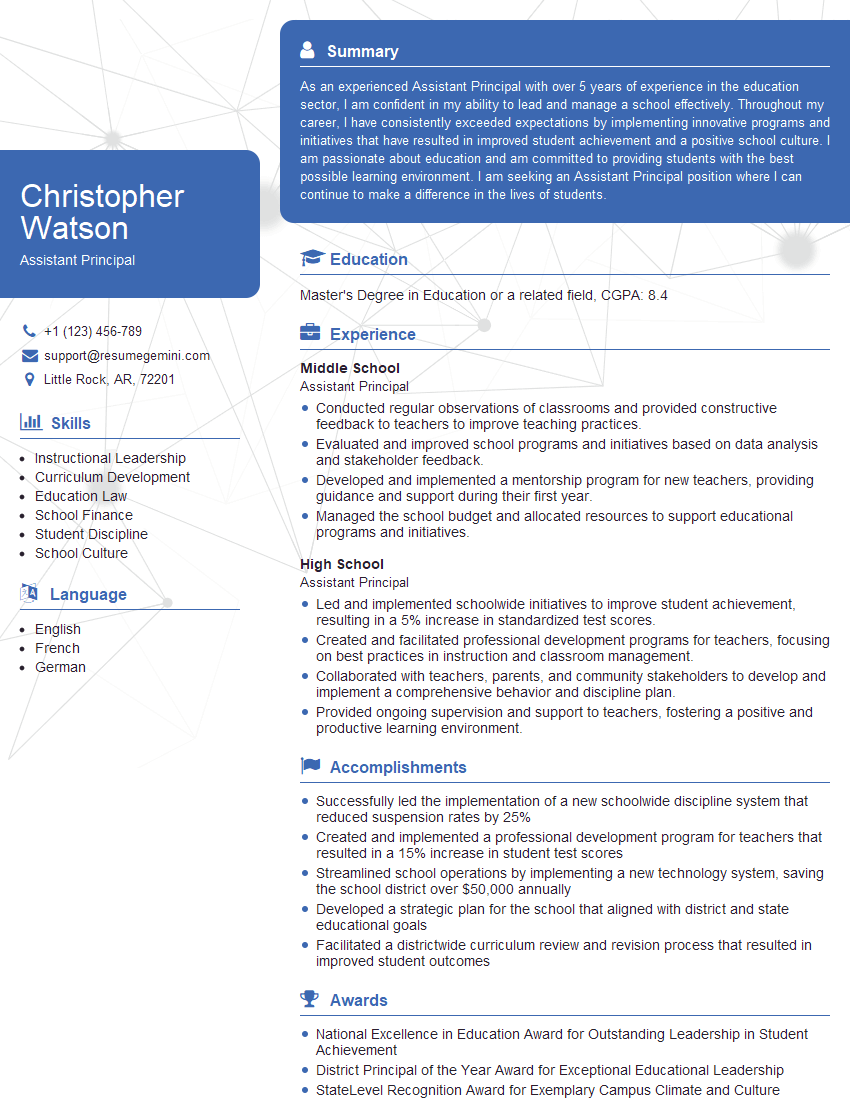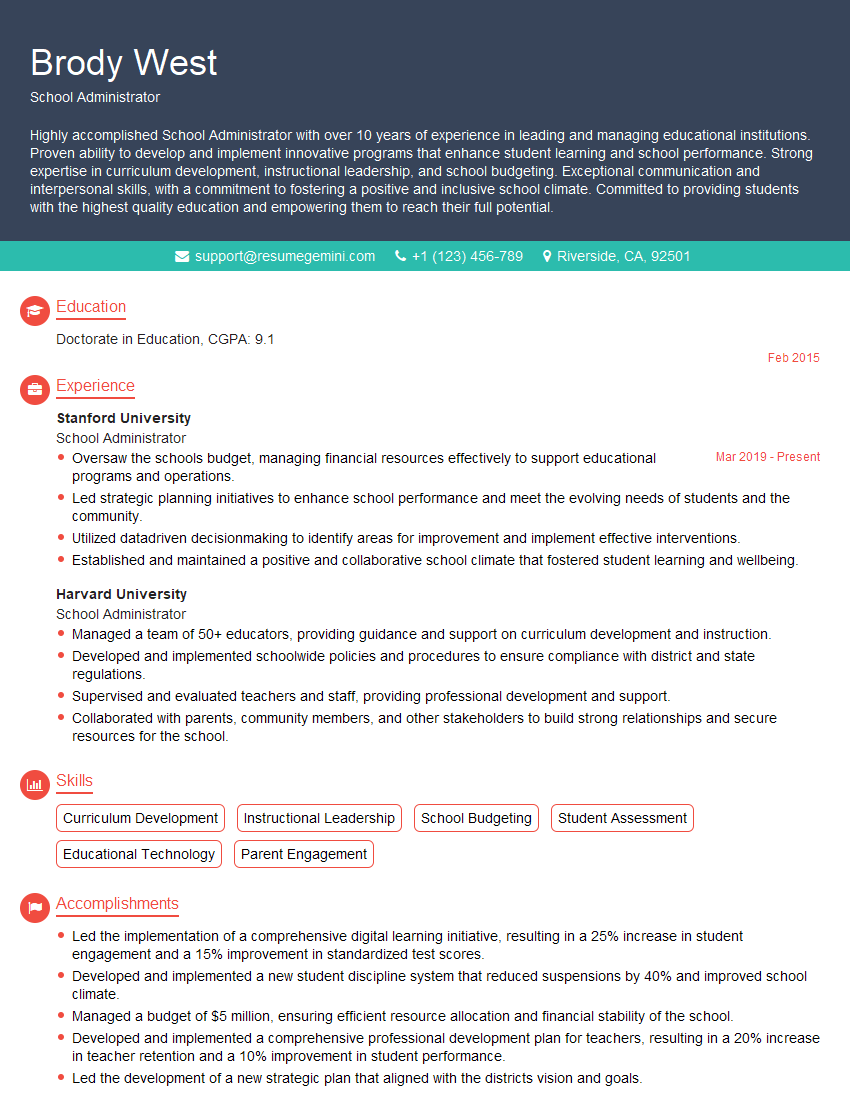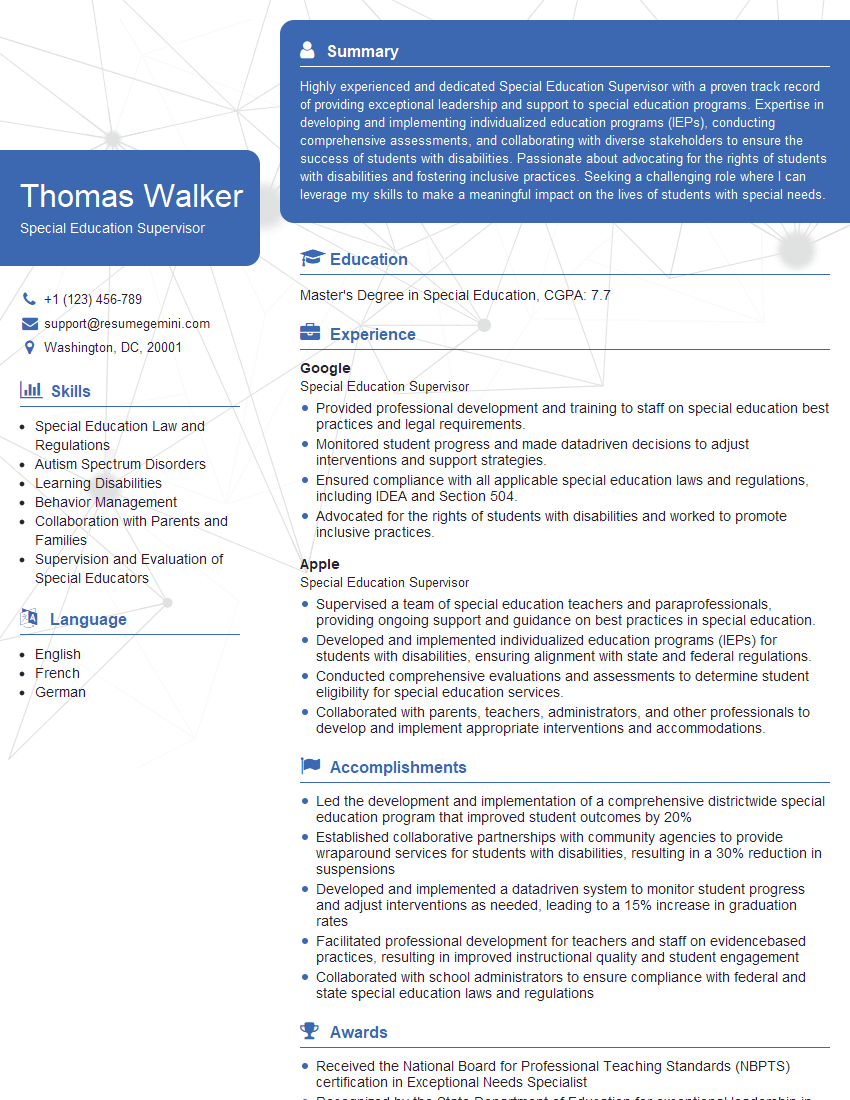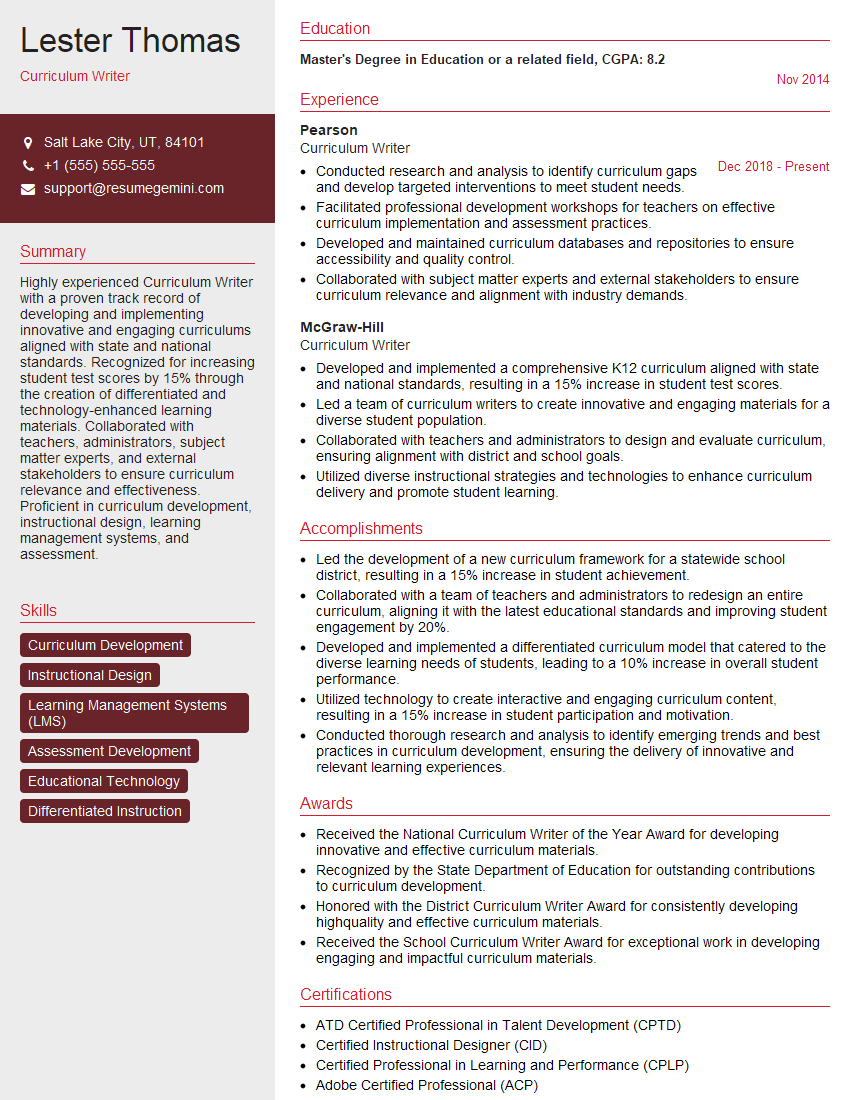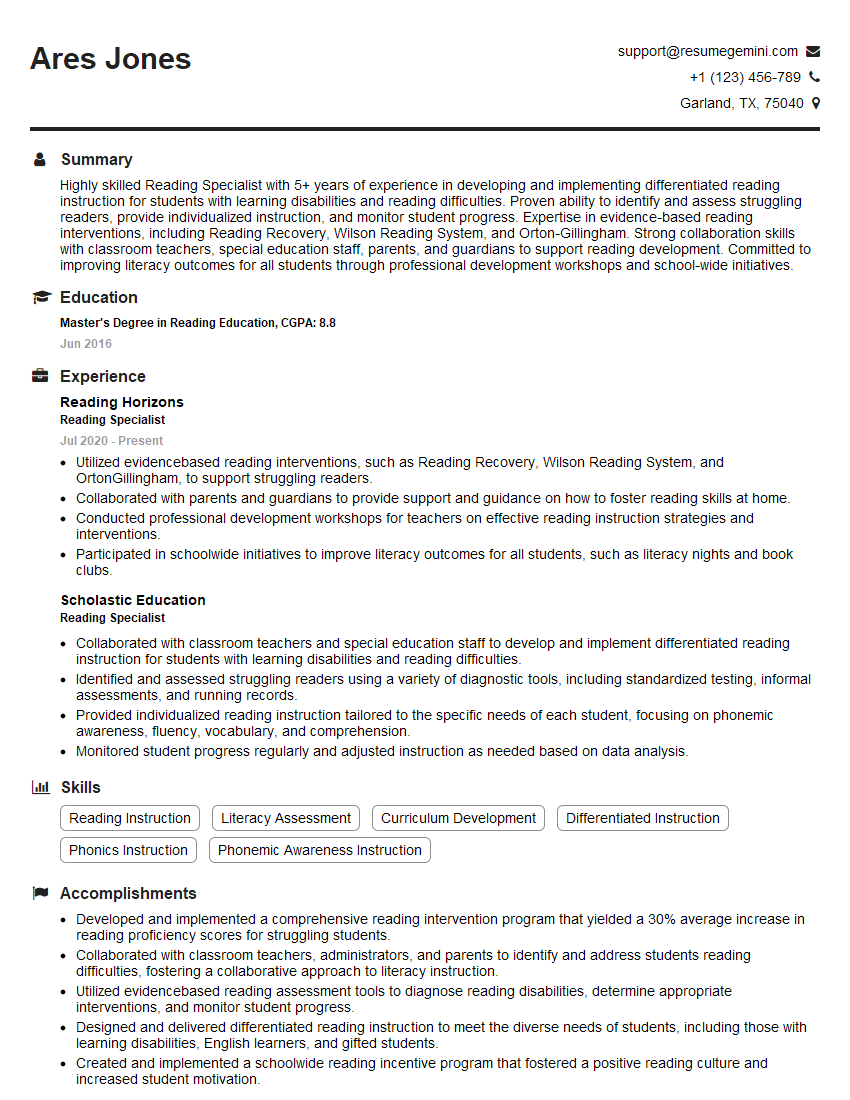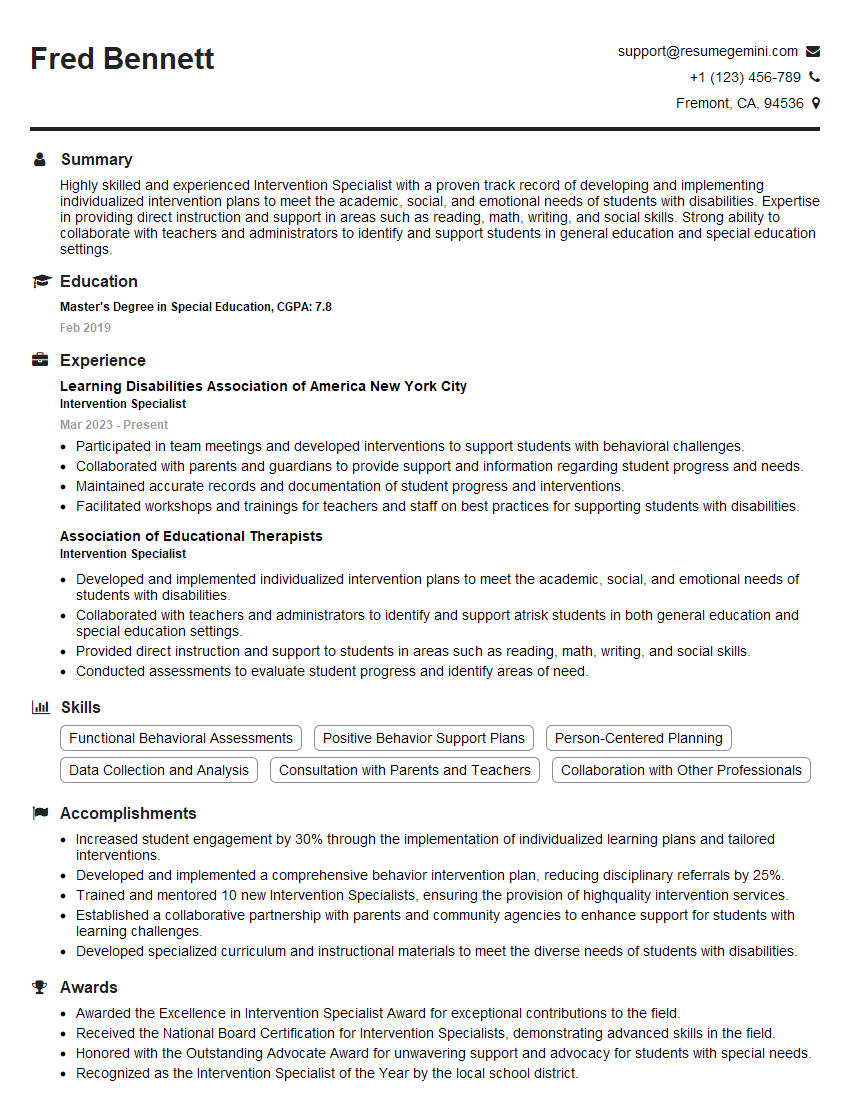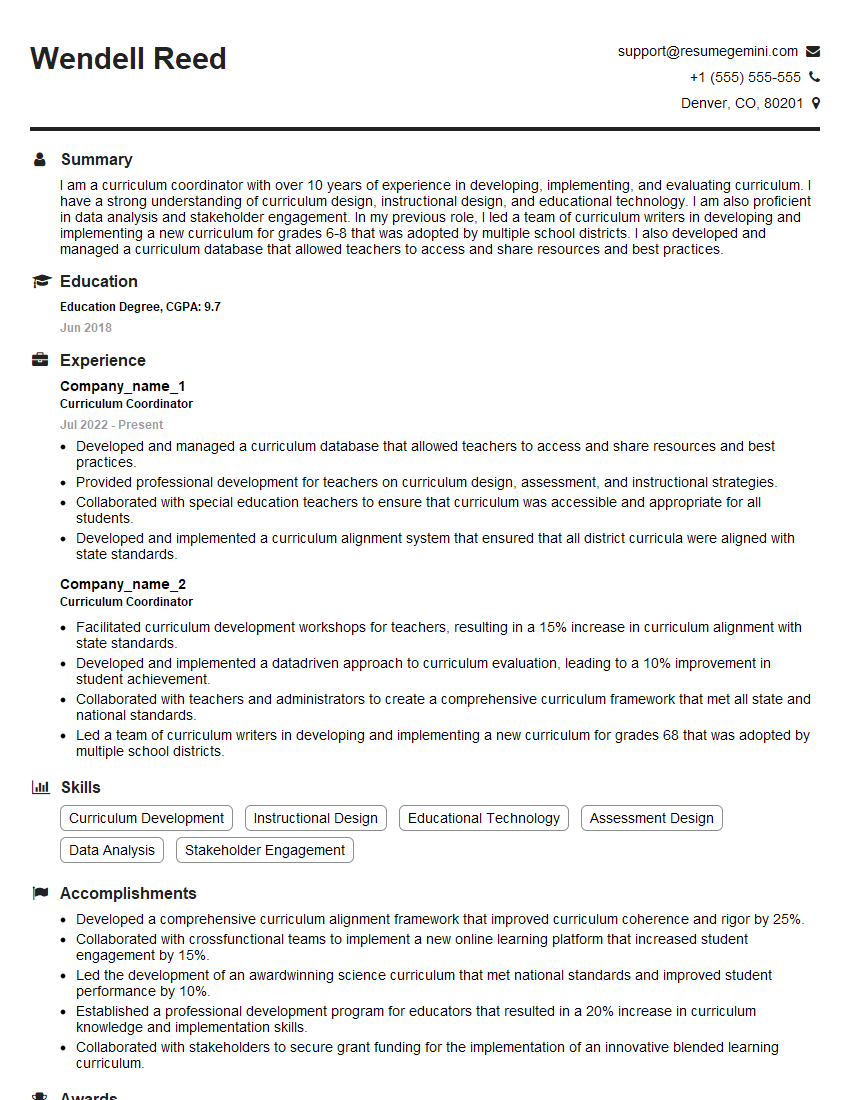Feeling uncertain about what to expect in your upcoming interview? We’ve got you covered! This blog highlights the most important Differentiated instruction strategies interview questions and provides actionable advice to help you stand out as the ideal candidate. Let’s pave the way for your success.
Questions Asked in Differentiated instruction strategies Interview
Q 1. Explain the concept of differentiated instruction.
Differentiated instruction is a teaching approach that recognizes and responds to the diverse learning needs of students. Instead of a ‘one-size-fits-all’ approach, it tailors the content, process, product, and learning environment to meet individual student needs. Think of it like a tailor making a suit – each person gets a unique garment that fits perfectly, instead of everyone wearing the same ill-fitting outfit. This involves understanding students’ readiness, learning styles, and interests and adapting instruction accordingly.
Q 2. Describe three different ways to differentiate instruction based on student readiness.
Differentiating based on student readiness focuses on providing varying levels of challenge and support. Here are three ways to do this:
Tiered Assignments: Create different versions of the same assignment, each requiring a different level of complexity. For example, in a math lesson on fractions, a Tier 1 assignment might involve simple addition and subtraction of fractions, Tier 2 might incorporate mixed numbers and word problems, and Tier 3 might require students to solve complex equations involving fractions and other operations.
Flexible Grouping: Group students based on their current understanding of a concept. You might have small groups working together on different aspects of a project or solving problems at varying difficulty levels. This allows for peer teaching and support.
Choice Boards: Offer students a selection of activities related to the same learning objective, each at a different level of challenge. Students choose the activities that best suit their readiness. This gives students ownership over their learning.
Q 3. How do you differentiate instruction based on student learning styles?
Differentiating for learning styles involves catering to how students best learn and process information. While the concept of distinct learning styles (visual, auditory, kinesthetic) is debated in its strict categorization, acknowledging individual preferences in information processing is crucial. This means incorporating a variety of instructional strategies:
Visual Learners: Use diagrams, charts, videos, and graphic organizers.
Auditory Learners: Incorporate discussions, lectures, audio recordings, and think-pair-share activities.
Kinesthetic Learners: Use hands-on activities, manipulatives, movement, and role-playing.
It’s important to remember that many students are a blend of styles, and providing a multimodal approach often benefits everyone.
Q 4. How do you differentiate instruction based on student interests?
Differentiating based on student interests involves tapping into students’ passions to increase engagement and motivation. This can be achieved through:
Choice in Projects: Allow students to choose from a range of projects or topics that align with the curriculum objectives but cater to different interests. For example, in a history unit, students could choose to create a documentary, write a fictional story, design a museum exhibit, or build a model related to the historical period.
Inquiry-Based Learning: Encourage student-led investigations into topics they find engaging. This allows students to pursue their interests while still meeting learning goals.
Connecting Content to Real-World Applications: Show students how the material is relevant to their lives and interests. For example, in a math lesson on percentages, you can relate it to sales, discounts, or sports statistics.
Q 5. Describe a time you differentiated instruction for a student with an IEP.
I once had a student, Alex, with an IEP for dyslexia. He struggled with reading fluency and written assignments. To differentiate instruction, I provided him with audiobooks for reading assignments, allowing him to access the content without the frustration of decoding. For writing assignments, I used assistive technology like text-to-speech software and speech-to-text software to help him compose his work. I also broke down writing tasks into smaller, manageable steps, providing regular feedback and support. I adjusted the length and complexity of assignments to suit his needs. His progress was significant; he began to participate more actively in class and his confidence grew considerably.
Q 6. How do you assess student learning in a differentiated classroom?
Assessment in a differentiated classroom needs to be flexible and multifaceted. It shouldn’t just focus on a single standardized test. I use a variety of assessment methods to get a comprehensive picture of student learning:
Formative Assessments: Ongoing checks for understanding, like exit tickets, quick writes, or informal observations. These allow me to adjust my instruction in real-time.
Summative Assessments: End-of-unit tests or projects that evaluate overall mastery of concepts. These can be differentiated based on readiness, offering different levels of challenge.
Performance-Based Assessments: Allow students to demonstrate their learning through projects, presentations, or portfolios that showcase their skills and knowledge in diverse ways.
Self and Peer Assessments: Encourage students to reflect on their own learning and provide feedback to their peers. This fosters metacognition and collaboration.
The key is to use assessment data to inform instruction and provide targeted support to each student.
Q 7. What are some common challenges in implementing differentiated instruction, and how do you address them?
Implementing differentiated instruction can present challenges. One common challenge is the increased workload for teachers. To address this, I use efficient planning strategies, such as creating templates for differentiated activities or leveraging technology to streamline tasks. Another challenge is managing multiple groups and activities simultaneously. I utilize flexible grouping strategies, allowing students to work independently, in pairs, or in small groups as needed. Also, ensuring all students have access to appropriate materials and resources can be challenging. I address this by creating a well-organized learning environment and utilizing school resources efficiently. Finally, parents sometimes misunderstand differentiated instruction, believing it means their child is receiving less than others. Open communication, explaining the benefits and sharing student progress regularly, helps alleviate these concerns. Ultimately, careful planning, organization, and strong communication are key to overcoming these challenges.
Q 8. How do you ensure all students are challenged and engaged in a differentiated classroom?
Ensuring all students are challenged and engaged in a differentiated classroom requires a multifaceted approach. It’s not about giving different students different work, but rather providing the right work for each student’s unique needs and learning style. This involves understanding individual student strengths, weaknesses, and learning preferences.
My strategy involves a three-pronged approach: 1. Offering tiered assignments: I design assignments with varying levels of complexity, allowing students to select the challenge that best fits their abilities. For example, in a writing assignment, a Tier 1 task might be a simple paragraph, Tier 2 a multi-paragraph essay, and Tier 3 an essay incorporating research. 2. Providing choice: I offer students choices in how they demonstrate their learning. For instance, students might choose to present their understanding through a presentation, a written report, a visual project, or a performance. 3. Using flexible grouping: I move students between individual work, small group work, and whole-class instruction based on their needs. A struggling student might benefit from one-on-one support, while a gifted learner might thrive in a group focused on advanced concepts.
Imagine a classroom studying the American Revolution. One student might be ready for analyzing primary source documents, another might need a simplified graphic organizer to comprehend key events, and another might excel at creating a dramatic reenactment. Differentiation allows me to cater to each of these learning needs and ensure each student feels challenged and successful.
Q 9. How do you use formative assessment to inform your differentiated instruction?
Formative assessment is the cornerstone of my differentiated instruction. It’s not just about testing what students know, but about continuously gathering information to adjust my teaching and meet individual needs. I use a variety of formative assessment methods including:
- Exit tickets: Short, quick assessments given at the end of class to check for understanding.
- Quick writes: Short writing prompts that help students articulate their thinking.
- Think-pair-share: Students discuss their understanding with a partner before sharing with the whole class.
- Observations: I carefully observe students during activities, noting their engagement levels and understanding.
- Informal questioning: Asking targeted questions to gauge individual student comprehension.
The data gathered from these assessments informs my instructional decisions. For example, if I notice a significant number of students struggling with a particular concept through exit tickets, I’ll dedicate more time to re-teaching that concept using different strategies. If a student consistently excels on assessments, I’ll provide more challenging extensions or enrichment activities. It’s a continuous cycle of assessment, instruction, and adjustment.
Q 10. Explain your approach to grouping students for differentiated instruction.
My approach to grouping students is highly flexible and depends on the specific learning objective and the students’ needs. I avoid fixed groups and instead use a variety of grouping strategies, including:
- Homogeneous grouping: Grouping students with similar skill levels allows me to target instruction to specific needs. This might be used for remediation or enrichment.
- Heterogeneous grouping: Grouping students with diverse skill levels encourages peer teaching and collaboration. Students can learn from each other’s strengths.
- Individual work: Some tasks benefit from independent learning, allowing students to work at their own pace.
- Flexible grouping: Students might move between different groups depending on the activity and their needs. This is my most frequently used method.
For example, during a collaborative project, I might create heterogeneous groups to encourage peer learning. However, for a challenging problem-solving activity, I might use homogeneous grouping to ensure students have the necessary support. The key is to be intentional and strategic in my grouping decisions to maximize student learning.
Q 11. How do you differentiate instruction for students with diverse learning needs?
Differentiating instruction for students with diverse learning needs is crucial for creating an inclusive classroom. I begin by understanding each student’s Individualized Education Program (IEP) or 504 plan, collaborating closely with special education teachers and related service providers. My strategies include:
- Adapting materials: I modify materials to meet individual needs, using different fonts, sizes, and formats as needed. For example, I might provide audio versions of readings for students with visual impairments or use graphic organizers for students who need visual support.
- Providing accommodations: I offer accommodations such as extra time, preferential seating, or assistive technology to support students’ learning.
- Modifying assessments: I modify assessments to align with individual needs, providing alternative assessment methods when appropriate.
- Collaborating with specialists: I work closely with special education teachers, speech therapists, and other specialists to develop and implement effective strategies.
For a student with ADHD, I might provide frequent breaks and opportunities for movement. For a student with dyslexia, I might use multi-sensory learning strategies and provide extra time for assignments. The key is to be flexible and responsive to each student’s unique needs.
Q 12. Describe your experience using technology to support differentiated instruction.
Technology plays a significant role in supporting my differentiated instruction. I utilize a variety of educational technologies, including:
- Learning management systems (LMS): LMS platforms like Google Classroom or Canvas allow me to easily assign and track student work, provide individualized feedback, and communicate with students and parents.
- Interactive whiteboards: Interactive whiteboards allow for engaging lessons and collaborative activities.
- Educational apps and websites: I use a range of apps and websites tailored to different learning styles and subject areas. For example, Khan Academy offers personalized learning paths, while IXL provides targeted practice in various subjects.
- Assistive technology: I use assistive technologies like text-to-speech software or speech-to-text software to support students with diverse learning needs.
For example, I might use a website that provides adaptive practice to help students who need extra support in math, or use an interactive whiteboard to create engaging activities for a whole-class lesson. The possibilities are endless when it comes to utilizing technology to personalize learning.
Q 13. How do you communicate your differentiated instruction plan to parents?
Communicating my differentiated instruction plan to parents is essential for building strong home-school partnerships. I utilize a variety of methods including:
- Parent-teacher conferences: I use parent-teacher conferences to explain my approach to differentiation, discuss individual student progress, and answer any parent questions.
- Newsletters and emails: I regularly send out newsletters or emails updating parents on classroom activities and highlighting the benefits of differentiated instruction.
- Progress reports: I provide regular progress reports that show individual student progress and highlight areas of strength and weakness.
- Online platforms: I use online platforms like Google Classroom or Seesaw to share student work and communicate updates with parents.
I emphasize that differentiation is about meeting each student’s unique needs and fostering their individual success. By clearly explaining my approach and keeping parents informed, I create a collaborative learning environment that benefits all students. I also provide examples of the tiered assignments or choice boards to help parents understand what their child is working on and how it fits their individual needs.
Q 14. What resources do you utilize to support differentiated instruction?
I utilize a variety of resources to support my differentiated instruction. These include:
- Curriculum materials: I use a variety of textbooks, workbooks, and other curriculum materials to provide different levels of support.
- Educational websites and apps: I use a wide range of educational websites and apps to supplement my instruction and provide targeted practice.
- Professional development: I participate in ongoing professional development to stay updated on the latest research and best practices in differentiated instruction.
- Collaboration with colleagues: I regularly collaborate with colleagues to share ideas, resources, and best practices.
- Student data: I use student data from formative and summative assessments to inform my instructional decisions. This data helps me identify students’ strengths and weaknesses and tailor my teaching accordingly.
By utilizing these resources, I am able to effectively meet the diverse learning needs of all my students and create a dynamic and engaging learning environment.
Q 15. How do you differentiate homework assignments?
Differentiating homework assignments means tailoring the work to meet the diverse needs and learning styles of my students. I avoid a one-size-fits-all approach, instead providing options that cater to varying levels of readiness, interest, and learning profiles. This might involve offering choices in the type of assignment, the complexity of the task, or the format of the submission.
Choice of Assignment: Students might choose between writing a short essay, creating a presentation, designing a poster, or developing a short video, all addressing the same learning objective.
Complexity of Task: I might offer different versions of the same assignment. A simpler version could focus on basic comprehension, while a more challenging version might delve into analysis and critical thinking. For example, one student might summarize a chapter, while another analyzes its themes and literary devices.
Format of Submission: Some students might prefer writing, others visual representation, and still others oral presentation. I offer options to match their preferences, like allowing students to create a podcast instead of a written report.
The key is to ensure all assignments align with the learning objectives, providing appropriate challenges and support for each student.
Career Expert Tips:
- Ace those interviews! Prepare effectively by reviewing the Top 50 Most Common Interview Questions on ResumeGemini.
- Navigate your job search with confidence! Explore a wide range of Career Tips on ResumeGemini. Learn about common challenges and recommendations to overcome them.
- Craft the perfect resume! Master the Art of Resume Writing with ResumeGemini’s guide. Showcase your unique qualifications and achievements effectively.
- Don’t miss out on holiday savings! Build your dream resume with ResumeGemini’s ATS optimized templates.
Q 16. How do you adapt your instruction based on real-time student responses?
Adapting instruction in real-time based on student responses is crucial for effective differentiated instruction. I constantly monitor student engagement and understanding through observation, questioning, and informal assessments. If I notice students struggling with a concept, I immediately adjust my teaching strategy. This might involve:
Re-explaining the concept using different terminology or examples: I might use a simpler analogy or relate the concept to their interests.
Providing additional support: This could involve small group instruction, one-on-one tutoring, or providing access to supplementary materials.
Adjusting the pacing: If students grasp a concept quickly, I can move on to the next topic. If they need more time, I slow down and provide further practice.
Using formative assessments: Quick checks for understanding, like exit tickets or quick quizzes, help me gauge student learning and identify areas needing further attention.
For example, if during a lesson on fractions, I notice many students are struggling with visualizing them, I might use manipulatives like fraction circles or incorporate a visual representation software to support their understanding. Continuous observation and flexible adjustment are paramount.
Q 17. Describe a time you had to modify your differentiated instruction plan due to unforeseen circumstances.
During a unit on Shakespeare, a severe snowstorm caused a power outage, disrupting our planned technology-based lesson on iambic pentameter. My original plan involved using interactive online tools and collaborative digital activities. However, I quickly adapted by using the unexpected downtime to our advantage. I transitioned to a more hands-on, low-tech approach.
We engaged in creative activities like writing our own Shakespearean insults or performing scenes from the play using only props found in the classroom. This unexpected turn fostered creative problem-solving and collaboration, highlighting the resilience and adaptability of both the students and myself. The students actually enjoyed the change in pace and the creative freedom it offered. While the technology-based activities were important for enhancing the lesson, the impromptu adaptations enriched the overall learning experience in a completely unforeseen, positive way.
Q 18. How do you ensure equitable access to learning for all students in a differentiated classroom?
Ensuring equitable access to learning in a differentiated classroom requires proactive planning and thoughtful implementation. Equity means ensuring all students have the resources and support they need to succeed, not simply treating everyone the same. I achieve this through:
Universal Design for Learning (UDL) principles: I incorporate multiple means of representation, action and expression, and engagement to cater to diverse learning styles and needs.
Providing varied learning materials and resources: This includes audiobooks, graphic organizers, manipulatives, and technology tools to address various learning preferences.
Offering flexible seating arrangements: Students can choose seating arrangements that best suit their focus and learning style.
Building strong student-teacher relationships: Understanding individual student needs and preferences is key to effective differentiation.
Collaborating with specialists: Working with special education teachers, counselors, and other support staff ensures students with IEPs or 504 plans receive appropriate accommodations.
It’s about proactively anticipating and addressing potential barriers to learning for all students, empowering them to reach their full potential.
Q 19. What are some strategies for differentiating instruction in a large class size?
Differentiating instruction in large classes requires strategic planning and the effective use of classroom management techniques. Here are some strategies:
Flexible grouping: Utilize a mix of whole-class instruction, small group activities, and independent work to cater to diverse learning needs.
Technology integration: Learning management systems (LMS) and educational apps can provide personalized learning experiences and support differentiated assignments.
Differentiated learning centers or stations: Students can rotate through various learning activities tailored to their strengths and needs.
Peer tutoring and collaborative learning: Students can learn from and support each other.
Clearly defined expectations and routines: This ensures efficient classroom management and allows for smooth transitions between activities.
For instance, I might use online platforms to assign different levels of reading comprehension tasks, allowing students to work at their own pace. Simultaneously, I could conduct small group instruction to address specific learning needs within the larger class context.
Q 20. How do you manage the workload associated with planning for differentiated instruction?
Managing the workload of differentiated instruction requires efficient planning and organizational strategies. I find these techniques helpful:
Pre-planning and template creation: Developing reusable templates and lesson plans for different activities or assignments saves time.
Utilizing technology: Learning management systems (LMS), grading software, and other tools streamline administrative tasks.
Prioritizing tasks: Focusing on the most impactful differentiation strategies rather than trying to differentiate every aspect of every lesson.
Collaboration with colleagues: Sharing resources and lesson plans with colleagues can reduce individual workload and foster professional growth.
Utilizing student feedback: Gathering student feedback helps refine the differentiation process and allows for adjustments based on what works best.
By streamlining my planning process and focusing on efficiency, I can effectively manage the workload associated with differentiated instruction.
Q 21. Explain how you use tiered assignments to differentiate instruction.
Tiered assignments offer a structured approach to differentiation where students receive different versions of the same assignment, each tailored to their individual readiness levels. The tiers typically involve a basic level, a medium level, and an advanced level.
Example: Let’s say I’m teaching a lesson on calculating the area of shapes. My tiered assignments might look like this:
Tier 1 (Basic): Students practice calculating the area of squares and rectangles using a worksheet with simple examples and step-by-step instructions. This focuses on fundamental concepts.
Tier 2 (Medium): Students calculate the area of squares, rectangles, and triangles using a worksheet with more complex examples and requiring more problem-solving skills.
Tier 3 (Advanced): Students calculate the area of complex shapes that require breaking down the shapes into smaller components, integrating problem-solving and critical thinking. This might involve irregular shapes or shapes combined.
Each tier aligns with the learning objective but provides varying levels of challenge and support, ensuring all students are appropriately challenged and engaged while working towards the same learning goal.
Q 22. How do you incorporate student choice into your differentiated instruction?
Incorporating student choice is fundamental to effective differentiated instruction. It allows learners to engage with material in ways that best suit their learning styles and preferences, increasing motivation and understanding. I offer choice in several ways:
- Choice of activities: Students might choose between writing a report, creating a presentation, designing a game, or producing a video to demonstrate their understanding of a topic. For example, after learning about the American Revolution, students could choose to write a persuasive essay, create a historical timeline, or stage a debate.
- Choice of format: Students can select how they receive information. Some might prefer reading a text, while others might benefit from an audio recording or a visual diagram. For a science lesson on ecosystems, some students could read a textbook chapter, while others listen to a podcast or watch a short documentary.
- Choice of grouping: Students can work independently, with partners, or in small groups, depending on their learning needs and preferences. For a collaborative project on Shakespeare, students can choose to work individually on a character analysis, in pairs on scene interpretation, or in groups on a theatrical production.
- Choice of assessment: Students can select the format for demonstrating their learning, such as a test, a project, a presentation, or a portfolio. For a math unit on fractions, students can choose between taking a written test, creating a visual representation of fraction concepts, or solving real-world problems involving fractions.
Offering choice empowers students and fosters a sense of ownership over their learning, leading to increased engagement and better outcomes.
Q 23. Describe your understanding of Universal Design for Learning (UDL) and its connection to differentiated instruction.
Universal Design for Learning (UDL) is a framework that guides the creation of learning environments and materials that are accessible and engaging for all learners, regardless of their strengths, weaknesses, or learning styles. It focuses on providing multiple means of:
- Representation: Presenting information in various formats (text, audio, video, etc.)
- Action & Expression: Offering diverse ways for students to demonstrate their learning (writing, drawing, speaking, acting, etc.)
- Engagement: Motivating students by tapping into their interests and providing choices.
Differentiated instruction is a teaching approach that adapts instruction to meet the individual needs of learners. UDL and differentiated instruction are closely related. UDL provides the overarching framework, while differentiated instruction is the practical application. UDL principles inform the design of differentiated lessons, ensuring that all students have access to the curriculum and can participate meaningfully. For instance, a UDL-informed differentiated lesson on photosynthesis might offer multiple means of representation (textbook, diagram, video), multiple means of action & expression (written quiz, drawing, model building), and multiple means of engagement (group work, independent research, game-based learning).
Q 24. How do you differentiate instruction for gifted and talented students?
Differentiating for gifted and talented students requires providing opportunities for them to extend their learning beyond the standard curriculum. This involves:
- Acceleration: Allowing students to move ahead in the curriculum at a faster pace.
- Enrichment: Providing additional challenges and opportunities for exploration, such as independent research projects, advanced reading materials, or participation in specialized programs. For example, students excelling in math could engage in a coding project that applies mathematical concepts.
- Complexity: Offering more complex and challenging tasks that require higher-order thinking skills, such as problem-solving, critical analysis, and creative thinking. A history lesson could extend to students researching primary source documents to develop their own historical interpretations.
- Mastery-based learning: Allowing students to delve deeper into areas of interest at their own pace until mastery is achieved.
- Mentorship and collaboration: Connecting gifted students with mentors or peers who share similar interests, providing opportunities for collaboration and intellectual stimulation.
It’s crucial to avoid simply giving gifted students more work; the focus should be on providing engaging and intellectually stimulating activities that challenge them to reach their full potential.
Q 25. How do you differentiate assessment to accurately reflect student understanding in a differentiated classroom?
Assessment in a differentiated classroom must be flexible and varied to accurately reflect student understanding. I utilize a variety of assessment methods that align with the differentiated instruction provided, including:
- Formative assessments: Frequent checks for understanding throughout the learning process, such as exit tickets, quick writes, and informal observations. These provide valuable feedback that informs instructional adjustments.
- Summative assessments: End-of-unit assessments that evaluate overall learning. These can be varied to cater to different learning styles – for instance, offering a choice between a written test, a presentation, a portfolio, or a project.
- Authentic assessments: Real-world tasks that require students to apply their knowledge and skills, such as creating a presentation, designing a solution to a problem, or participating in a debate. This allows for a more holistic understanding of student abilities.
- Self and peer assessments: Engaging students in evaluating their own work and the work of their peers. This develops metacognitive skills and increases student accountability.
By employing diverse assessment methods, I gain a comprehensive picture of each student’s understanding, regardless of their learning style or preferred mode of expression.
Q 26. Describe a time you successfully used differentiated instruction to improve student outcomes.
In my previous role, I taught a seventh-grade science class covering the topic of ecosystems. Recognizing the diverse learning styles within the class, I differentiated instruction by offering multiple learning pathways. Some students opted for a traditional textbook approach, while others chose to build 3D models of different ecosystems or create interactive presentations using digital tools. The assessment was also differentiated. Students could choose to take a written test, create a presentation, or build a functioning model representing a chosen ecosystem. The results were remarkable. Students who struggled with traditional assessments excelled in the hands-on activities, while those who preferred more structured learning thrived in the traditional approach. The overall class performance significantly improved, demonstrating the success of differentiated instruction in catering to diverse learning needs and boosting student engagement and achievement.
Q 27. How do you ensure that your differentiated instruction aligns with curriculum standards?
Aligning differentiated instruction with curriculum standards is crucial for ensuring that all students meet the required learning objectives. I accomplish this by:
- Analyzing curriculum standards: Carefully reviewing the specific learning objectives, skills, and knowledge outlined in the curriculum. This forms the basis for planning differentiated instruction.
- Developing learning objectives for different learning styles and needs: Creating learning objectives that are tailored to diverse learners while maintaining alignment with the overall curriculum standards. These objectives might vary in complexity or require different approaches to achieve the same understanding.
- Using a variety of instructional strategies: Employing various teaching methods (e.g., cooperative learning, project-based learning, inquiry-based learning) to ensure students can access the material through their preferred learning channels. These strategies must be relevant to the standards being addressed.
- Choosing appropriate assessment measures: Selecting assessments that accurately measure student understanding of the curriculum standards, regardless of their chosen learning pathways.
- Regularly monitoring student progress: Continuously tracking student progress toward meeting the standards through formative and summative assessments. This enables me to adjust instruction as needed to better support all learners.
This ensures that despite the differentiation, all students are working toward the same academic benchmarks, achieving them through personalized learning pathways.
Key Topics to Learn for Differentiated Instruction Strategies Interview
- Understanding Diverse Learners: Explore various learning styles (visual, auditory, kinesthetic), learning preferences, and multiple intelligences. Consider how these impact teaching and learning.
- Planning for Differentiation: Learn to design engaging lessons that cater to diverse needs. This includes understanding formative and summative assessment strategies to inform instruction.
- Differentiating Content, Process, and Product: Master the three core dimensions of differentiation: adjusting the *what* (content), the *how* (process), and the *show* (product) of learning to meet individual student needs.
- Assessment and Feedback in Differentiated Instruction: Discuss various assessment methods (formative and summative) and their role in adapting instruction. Explore providing effective and timely feedback.
- Classroom Management and Organization: Explore strategies for managing a diverse classroom effectively, including techniques for flexible grouping and individual support.
- Technology Integration in Differentiated Instruction: Discuss how technology can be used to personalize learning experiences and cater to different learning styles and paces.
- Addressing IEPs and 504 Plans: Understand how to incorporate individualized education plans and 504 plans into differentiated instruction to support students with specific needs.
- Collaboration and Professional Development: Discuss the importance of collaboration with colleagues and ongoing professional development in refining differentiated instruction practices.
- Reflecting on Practice: Explain the importance of self-reflection and data analysis to continually improve differentiated instruction strategies.
Next Steps
Mastering differentiated instruction strategies is crucial for career advancement in education. Demonstrating your expertise in this area will significantly enhance your job prospects. To make the most of your job search, crafting an ATS-friendly resume is paramount. A well-structured resume highlighting your skills and experience in differentiated instruction will help you stand out from the competition. We recommend using ResumeGemini, a trusted resource, to build a professional and impactful resume. ResumeGemini provides examples of resumes tailored to differentiated instruction strategies, allowing you to tailor your own for maximum impact. Invest time in perfecting your resume; it’s your first impression on potential employers.
Explore more articles
Users Rating of Our Blogs
Share Your Experience
We value your feedback! Please rate our content and share your thoughts (optional).
What Readers Say About Our Blog
Hi, I’m Jay, we have a few potential clients that are interested in your services, thought you might be a good fit. I’d love to talk about the details, when do you have time to talk?
Best,
Jay
Founder | CEO
